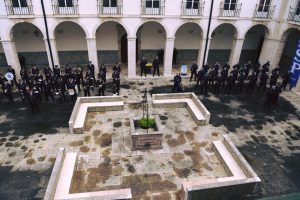Article author: Miky Weinberg – Owner of the Tarantula Technologies Ltd and Octagon Security Ltd Companies.
In the 1970s, the State of Israel experienced dozens of terrorist attacks by Palestinian organizations against innocent civilians. Some are considered damaging and daring attacks:
May 22, 1970 – 3 bazooka missiles are fired at the Avivim children’s bus.
May 8, 1972 – A hijacking of a Sabena Airlines plane from Brussels to Tel Aviv.
May 30, 1972 – The massacre at Ben Gurion Airport is carried out by three terrorists from the extremist communist organization the Japanese Red Army.
April 11, 1974 – A terrorist attack in Kiryat Shmona is carried out by 3 terrorists.
May 15, 1974 – The Maalot massacre was carried out by 3 terrorists.
March 6, 1975 – The attack on the Savoy Hotel in Tel Aviv.
March 11, 1978 – The Coastal Road attack is carried out by terrorists who came from the sea in rubber boats.
April 22, 1979 – A terrorist attack in Nahariya by a terrorist cell under the command of Samir Kuntar.
One of the last attacks of this decade took place outside the borders of Israel when on November 13, 1979, a Palestinian terrorist cell attempted to assassinate the Israeli ambassador to Lisbon, the late Mr. Ephraim Eldar, who began his role as Israel’s first ambassador to Portugal two years earlier.
Since then, the Israeli embassy in Lisbon, Portugal, has been located on the fourth floor of the same high-rise building where the assassination attempt on the late Ephraim Eldar took place.
Picture of the building where the Israeli embassy is located:
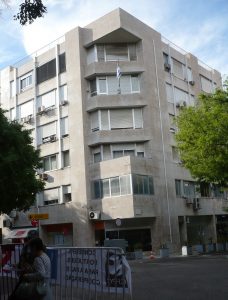
On the day of the assassination attempt (November 13, 1979), the security at the embassy included the Israeli security director and a local policeman. The ambassador’s security was carried out by the locals, this included an operational driver and close protection specialist. At around 09:30 the ambassador’s car arrived in front of the building and stopped parallel to the main entrance. The persons in the vehicle sat in accordance with the principles of close protection when in vehicles when the driver is in his seat, the close protection specialist next to him in the front seat, and the ambassador in the back seat behind the close protection specialist. The embassy’s security director was on the fourth floor and the local policeman was stationed near the stop. Immediately after the vehicle was stopped, the close protection specialist got out of the vehicle while holding the ambassador’s briefcase. The driver made sure to stay in place in the vehicle while staying in the drive gear and his foot on the brakes. Everything was ready for the ambassador to leave the vehicle. As soon as the ambassador opens the door and starts exiting the vehicle, a terrorist emerges towards the vehicle, starts firing multiple times with an automatic rifle, and then decides to go around the vehicle in order to apparently be able to attack the driver and the local policeman. As a result of the shooting, the local close protection specialist was killed and Ambassador Ephraim Eldar was wounded in the leg. Making the right decision, the ambassador manages to get back into the vehicle. At the same time, a second terrorist emerges and throws a grenade at the local policeman who was standing at the seam, apparently between the front door and the location of the ambassador’s vehicle. The policeman was injured in the grenade explosion and extricated himself into the building. The driver of the local car acts with an amazing instinct, which suits everything the embassy’s security director briefed him, presses the accelerator, and starts driving fast forward while running over the first terrorist who did not manage to get around the vehicle from the front. The two terrorists flee the scene and disappear and the driver evacuates the ambassador to the nearest police station. From there was transferred to the nearest hospital for further medical treatment.
According to eyewitnesses, the two terrorists waited for the ambassador’s vehicle to arrive near the embassy building in a white sedan, and when it arrived, they got out of it and moved in its direction. The terrorists who carried out the operation have not been apprehended to date.
Picture of the location of the embassy building and the nearby junction:
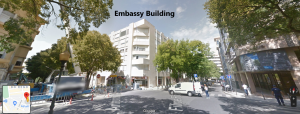
Pictures showing the location of the stopping point:
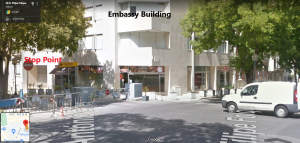
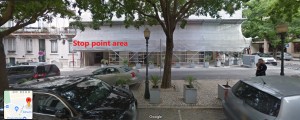
Coverage of the event in the local media:
Insights and lessons learned from the event:
In close protection, the stage of leaving or arriving at the seam at a permanent facility is defined as highly sensitive because the adversary has the ability to know the location of the embassy facility and find out if there is a pause when the ambassador arrives in the morning and plan his actions accordingly.
I assume the terrorists carried out operations to gather information on the level of security at the embassy and especially on the level of security of the ambassador at the time of his arrival in the morning. There is no doubt that the terrorists saw and recognized the fact that when the ambassador arrived at the embassy there was one policeman waiting at the stop and together with the ambassador there was a close protection specialist – the terrorists’ decision to deliberately assassinate at the entrance to the embassy, despite the presence of the security forces, is not coincidental. It seems that the security forces failed to create sufficient deterrence and the terrorists aspired to display a high level of ability, daring, determination, and added value and prestige. Those terrorists were able to locate a pattern of action by the ambassador in which he was secured solely by the attached close protection specialist and yet they chose to carry out the assassination in front of the Israeli embassy.
The local policeman and close protection specialist will forgive me for saying that the two terrorists would probably not have acted against them if they did not think they could defeat them and kill the ambassador.
The one who disrupted the plan for the terrorists was actually the driver who acted calmly and professionally, even though he was also injured during the first shooting. The local ambassador’s driver has proven in his actions that the role of the driver is a very important profession in a close protection array to the point of rescuing the principal from injury or death – a driver must remain in the vehicle until the principal arrives at his office in the building while keeping the vehicle in gear, just as the local driver did. The embassy staff did well in teaching the local driver what to do when arriving and stopping at the seam and how to act in an emergency.
A talented and skilled close protection array should know how to perform preliminary actions for the arrival of the principal, with an emphasis on actions to detect anomalies in the threatened sector and especially in the critical 15 minutes before the arrival.
There is no doubt that with the right scanning operations in order to detect anomalies in the area near the embassy building, the two terrorists could be identified sitting and waiting in the white sedan vehicle. In order to be able to see when the ambassador arrives at the embassy, the two terrorists stay at least 15 minutes or more near the embassy building while maintaining eye contact on the stopping point, so if the terrorists can see the stopping point, the close protection specialist can also see them.
One of the actions the close protection specialist must do after getting out of the vehicle and just before allowing the ambassador to leave is a quick visual scan from the location and out to try and locate anomalous persons, according to the description of the assassination sequence, the first terrorist must have been moving towards the vehicle before the ambassador opened it, so the terrorist could therefore be seen by the close protection specialist next to him and react.
In addition, it is important to note that the close protection specialist must leave both hands free and must not hold anything with them that could interfere and even prevent him from acting when necessary.
In the context of the location of the ambassador at the time of the ambassador’s arrival – in general, the Israeli security directors and close protection specialists are at a higher professional level than the local security force and are therefore expected to be involved in the ambassador’s security operations, especially in sensitive stages.
It should be noted that in June 1982, Abu Nidal’s men attempted to assassinate the Israeli ambassador to Britain, the late Shlomo Argov, who was seriously wounded and remained disabled for the rest of his life. As a result, Israel entered ֹOperation Peace for Galilee (later known as the First Lebanon War).
In 2019, the Israeli Ambassador in Lisbon, Mr. Rafi Gamzu, revealed that since the incident in which the local ambassador’s close protection specialist was killed, no memorial service has been held by the embassy and the local police, so as a result, he initiated a memorial service that was conducted at the national headquarters of the Portuguese police, with the participation of the police’s leadership, ministers, the Israeli embassy’s personnel and the close protection specialist’s family.
A picture from the exciting ceremony:
